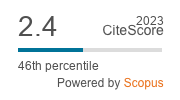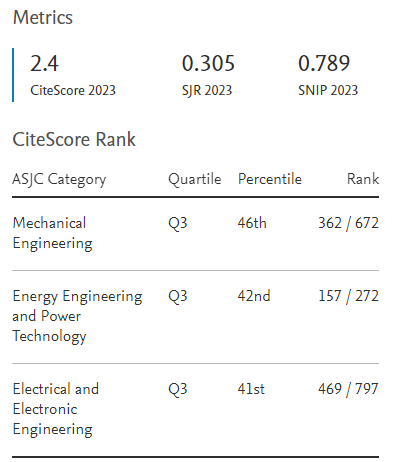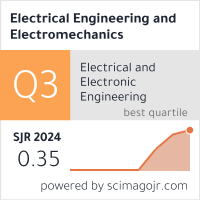Influence of the initial winding displacement on the indicators of the electromechanical induction accelerator of cylindrical configuration
DOI:
https://doi.org/10.20998/2074-272X.2021.5.01Keywords:
electromechanical induction accelerator, cylindrical configuration, initial winding displacement, capacitive energy storage, alternating voltage source, armature speedAbstract
Purpose. The purpose of the article is to determine the influence of the initial displacement of the windings on the indicators of an electromechanical induction accelerator of a cylindrical configuration with pulsed excitation from a capacitive energy storage and with short-term excitation from an alternating voltage source. Methodology. To take into account the interrelated electrical, magnetic, mechanical and thermal processes, as well as a number of nonlinear dependencies, we use the lumped parameters of the windings, and the solutions of the equations describing these processes are presented in a recurrent form. The mathematical model of the accelerator takes into account the variable magnetic coupling between the windings during the excitation of the inductor winding. When calculating the parameters and characteristics of the accelerator, a cyclic algorithm is used. Results. At a frequency of an alternating voltage source of 50 Hz, the current amplitude in the armature winding is less than in the inductor winding. With an increase in the source frequency to 250 Hz, the phase shift between the winding currents decreases. The current in the inductor winding decreases, and in the armature winding it increases. The accelerating components of the force increase, and the braking ones decrease. With an increase in the source frequency to 500 Hz, the current density in the armature winding exceeds that in the inductor winding. In this case, the phase shift between the windings is further reduced. Originality. When a cylindrical accelerator is excited, the largest amplitude of the current density in the inductor winding occurs at the maximum initial displacement of the windings, but the amplitude of the current density in the armature winding is the smallest. The largest value of the current density in the armature winding occurs in the absence of an initial displacement. When excited from a capacitive energy storage, the electrodynamic force between the windings has an initial accelerating and subsequent braking components. As a result, the speed of the armature initially increases to a maximum value, but decreases towards the end of the electromagnetic process. When a cylindrical accelerator is excited from an alternating voltage source, a phase shift occurs between the currents in the windings, which leads to the appearance of alternating accelerating and decelerating components of electrodynamic forces. The accelerating components of the force prevail over the braking components, which ensures the movement of the armature. Practical value. At a frequency of an alternating voltage source of 50 Hz, the highest speed at the output of the accelerator vzf=0.5 m/s is realized at an initial displacement of the windings z0=6.2 mm, at a frequency of 250 Hz, the highest speed vzf=2.4 m/s is realized at z0=3.1 mm, and at a frequency of 500 Hz the highest speed vzf=2.29 m/s is realized at z0=2.3 mm.
References
Guangcheng F., Wang Y., Xu Q., Xinyi N., Yan Z. Design and analysis of a novel three-coil reconnection electromagnetic launcher. IEEE Transactions on Plasma Science, 2019, vol. 47, no. 1, pp. 814-820. doi: https://doi.org/10.1109/tps.2018.2874287.
Puumala V., Kettunen L. Electromagnetic design of ultrafast electromechanical switches. IEEE Transactions on Power Delivery, 2015, vol. 30, no. 3, pp. 1104-1109. doi: https://doi.org/10.1109/tpwrd.2014.2362996.
Kostsov E.G. Microelectromechanical accelerator of solids. Optoelectronics, Instrumentation and Data Processing, 2012, no. 48, pp. 401-409. doi: https://doi.org/10.3103/S8756699012040115.
Reck B. First design study of an electrical catapult for unmanned air vehicles in the several hundred kilogram range. IEEE Transactions on Magnetics, 2003, vol. 39, no. 1, pp. 310-313. doi: https://doi.org/10.1109/tmag.2002.805921.
Chemeris V.T. Multistage induction accelerator of a macro-object: search for technical solutions. Artillery and small arms, 2011, no. 3 (40), pp. 45-51. (Rus).
Bolyukh V.F., Shchukin I.S. Lineinye induktsionno-dinamicheskie preobrazovateli [Linear induction-dynamic converters]. Saarbrucken, Germany, LAP Lambert Academic Publ., 2014. 496 p. (Rus).
Novakovic Z., Vasic Z., Ilic I., Medar N., Stevanovic D. Integration of tactical - medium range UAV and catapult launch system. Scientific Technical Review, 2016, vol. 66, no. 4, pp. 22-28. doi: https://doi.org/10.5937/str1604022n.
Angquist L., Baudoin A., Norrga S., Nee S., Modeer T. Low-cost ultra-fast DC circuit-breaker: Power electronics integrated with mechanical switchgear. 2018 IEEE International Conference on Industrial Technology (ICIT), 2018, pp. 1708-1713. doi: https://doi.org/10.1109/icit.2018.8352439.
Gerasimov Yu.V., Karetnikov G.K., Selivanov A.B., Fionov A.S. Evaluation of relative final mass of a nanosatellite delivered to the near-earth space using a pulsed launcher and a pulsed correcting thruster. Herald of the Bauman Moscow State Technical University. Series Mechanical Engineering, 2013, no. 3 (92), pp. 69-76. (Rus). Available at: http://vestnikmach.ru/articles/116/eng/116.pdf (accessed 15 May 2021).
Upshaw J.L., Kajs J.P. Micrometeoroid impact simulations using a railgun electromagnetic accelerator. IEEE Transactions on Magnetics, 1991, vol. 27, no. 1, pp. 607-610. doi: https://doi.org/10.1109/20.101103.
Bissal A. On the design of ultra-fast electro-mechanical actuators. Licentiate Thesis. Stockholm, Sweden, 2013. 76 p. Available at: https://www.diva-portal.org/smash/get/diva2:617236/FULLTEXT01.pdf (accessed 15 May 2021).
Torlin V.N. Vetrogon A.A., Ogryzkov S.V. Behavior of electronic units and devices under the influence of shock loads in an accident, Automobile transport, 2009, vol. 25, pp. 178-180. (Rus). Available at: https://dspace.khadi.kharkov.ua/dspace/bitstream/123456789/807/1/39.pdf (accessed 15 May 2021).
Kondratiuk M., Ambroziak L. Concept of the magnetic launcher for medium class unmanned aerial vehicles designed on the basis of numerical calculations, Journal of Theoretical and Applied Mechanics, 2016, vol. 54, no. 1, pp. 163-177. doi: https://doi.org/10.15632/jtam-pl.54.1.163.
Li S., Gui Y., Yu C., Liu P., Zhang P., Li J. Study on the effect and the direction accuracy of active electromagnetic protection system. IEEE Transactions on Magnetics, 2009, vol. 45, no. 1, pp. 351-353. doi: https://doi.org/10.1109/TMAG.2008.2008850.
Bolyukh V.F., Oleksenko S.V., Schukin I.S. Efficiency of linear pulse electromechanical converters designed to create impact loads and high speeds. Electrical Engineering & Electromechanics, 2015, no. 3, pp. 31-40. doi: https://doi.org/10.20998/2074-272X.2015.3.05.
Bolyukh V.F., Shchukin I.S. Influence of an excitation source on the power indicators of a linear pulse electromechanical converter of induction type. Technical Electrodynamics, 2021, no. 3, pp. 28-36. doi: https://doi.org/10.15407/techned2021.03.028.
Bolyukh V.F., Katkov I.I. Influence of the Form of Pulse of Excitation on the Speed and Power Parameters of the Linear Pulse Electromechanical Converter of the Induction Type. Volume 2B: Advanced Manufacturing, Nov. 2019, 8 p. doi: https://doi.org/10.1115/imece2019-10388.
Bolyukh V.F., Kashansky Yu.V., Schukin I.S. Features of excitation of a linear electromechanical converter of induction type from an AC source. Electrical Engineering & Electromechanics, 2021, no. 1, pp. 3-9. doi: https://doi.org/10.20998/2074-272x.2021.1.01.
Bolyukh V.F., Shchukin I.S. The thermal state of an electromechanical induction converter with impact action in the cyclic operation mode, Russian Electrical Engineering, 2012, vol. 83, no. 10, pp. 571-576. doi: https://doi.org/10.3103/S1068371212100045.

Downloads
Published
How to Cite
Issue
Section
License
Copyright (c) 2021 V. F. Bolyukh, I. S. Schukin, J. Lasocki

This work is licensed under a Creative Commons Attribution-NonCommercial 4.0 International License.
Authors who publish with this journal agree to the following terms:
1. Authors retain copyright and grant the journal right of first publication with the work simultaneously licensed under a Creative Commons Attribution License that allows others to share the work with an acknowledgement of the work's authorship and initial publication in this journal.
2. Authors are able to enter into separate, additional contractual arrangements for the non-exclusive distribution of the journal's published version of the work (e.g., post it to an institutional repository or publish it in a book), with an acknowledgement of its initial publication in this journal.
3. Authors are permitted and encouraged to post their work online (e.g., in institutional repositories or on their website) prior to and during the submission process, as it can lead to productive exchanges, as well as earlier and greater citation of published work.




